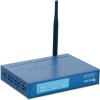TRENDnet TEW-453APB User Guide - Page 97
Channels, WPA-PSK, WPA-802.1x, Roaming, If WEP is used
 |
UPC - 710931502732
View all TRENDnet TEW-453APB manuals
Add to My Manuals
Save this manual to your list of manuals |
Page 97 highlights
Wireless Access Point User Guide As Wireless Stations are physically moved through the area covered by an ESS, they will automatically change to the Access Point which has the least interference or best performance. This capability is called Roaming. (Access Points do not have or require Roaming capabilities.) Channels The Wireless Channel sets the radio frequency used for communication. • Access Points use a fixed Channel. You can select the Channel used. This allows you to choose a Channel which provides the least interference and best performance. For 802.11g, 13 channels are available in the USA and Canada., but 11channels are available in North America if using 802.11b. • If using multiple Access Points, it is better if adjacent Access Points use different Channels to reduce interference. The recommended Channel spacing between adjacent Access Points is 5 Channels (e.g. use Channels 1 and 6, or 6 and 11). • In "Infrastructure" mode, Wireless Stations normally scan all Channels, looking for an Access Point. If more than one Access Point can be used, the one with the strongest signal is used. (This can only happen within an ESS.) • If using "Ad-hoc" mode (no Access Point), all Wireless stations should be set to use the same Channel. However, most Wireless stations will still scan all Channels to see if there is an existing "Ad-hoc" group they can join. WEP WEP (Wired Equivalent Privacy) is a standard for encrypting data before it is transmitted. This is desirable because it is impossible to prevent snoopers from receiving any data which is transmitted by your Wireless Stations. But if the data is encrypted, then it is meaningless unless the receiver can decrypt it. If WEP is used, the Wireless Stations and the Wireless Access Point must have the same settings. WPA-PSK Like WEP, data is encrypted before transmission. WPA is more secure than WEP, and should be used if possible. The PSK (Pre-shared Key) must be entered on each Wireless station. The 256Bit encryption key is derived from the PSK, and changes frequently. WPA-802.1x WPA-802.1x - This version of WPA requires a Radius Server on your LAN to provide the client authentication according to the 802.1x standard. Data transmissions are encrypted using the WPA standard. If this option is used: • The Access Point must have a "client login" on the Radius Server. • Each user must have a "user login" on the Radius Server. Normally, user authentication is done via a digital certificate, so the Radius login requires no action by the user. • Each user's wireless client must support 802.1x and provide the login data when required. • All data transmission is encrypted using the WPA standard. Keys are automatically generated, so no key input is required. 94















